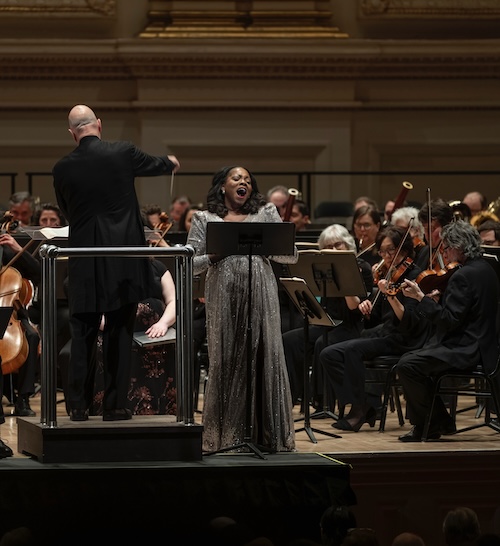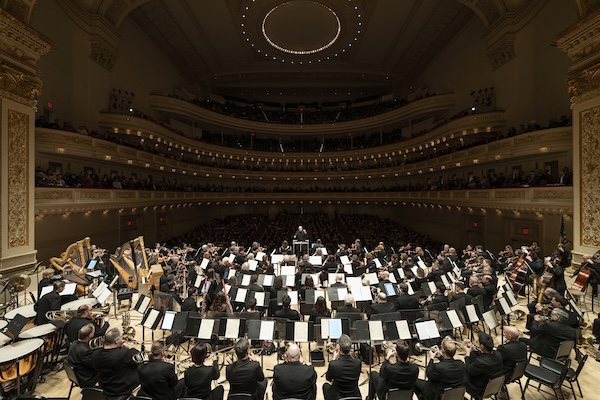Botstein, ASO and a cast of hundreds scale Schoenberg’s massive “Gurre-Lieder”

Did Romanticism in music collapse of its own weight? Some think so, and cite personnel-heavy works such as Mahler’s Symphony No. 8 (the so-called “Symphony of a Thousand”) and Strauss’s Eine Alpensinfonie as the last word, or last note, in musical grandiosity.
Those pieces are still heard in concert regularly around the world. Arnold Schoenberg’s orchestral-choral song cycle Gurre-Lieder, on the other hand, has achieved a kind of mythic status as the late-late-Romantic piece that’s almost too big to actually perform.
Begun in 1900, when Schoenberg was a 26-year-old disciple of (you guessed it) Mahler and Strauss, and retrospectively finished 12 years later, when he was already in his atonal period, Gurre-Lieder does indeed populate the stage, calling for about 150 instrumentalists and 200 singers.
Still, as the American Symphony Orchestra demonstrated Friday night in Carnegie Hall, it’s perfectly possible—with a plan, determination, and a bit of funding—to get that many capable musicians together and have a go at it. It was a rare opportunity to hear and see this mythical beast up close.
And guess what? The fearsome creature turned out to be a pussycat. The lushly Romantic garland of songs for tenor and soprano soloists, with a Tristan-like medieval love triangle at its center, eventually branched out into other characters, a bit of comic relief, and some rousing choruses. All in all, a satisfying evening of daring but accessible music.
The mid-19th-century poems by Jens Peter Jacobsen, translated from Danish to German by Schoenberg’s contemporary Robert Franz Arnold, told of the love of King Waldemar for Tove, a lady of his court at Gurre Castle, and the murderous jealousy of Queen Helvig. After the queen had Tove poisoned, Waldemar cursed God for her death, and was therefore condemned to lead a ghost army every night on a “wild hunt” across Gurre Lake.
The tale itself is told almost entirely in narration, first in the expressive sung monologue of the Wood-Dove that closes Part I, later by a Narrator in Schoenberg’s first use of Sprechstimme, the talk-sing technique he would develop further in the chamber work Pierrot Lunaire. That left the human characters to reflect poetically on the story, on love and death and nature. (The voluminous text of this through-composed, two-hour work had to be printed so small in the booklet that it was unreadable in the hall’s semi-darkness.)
Reversing the dawn-to-dusk scenario of Strauss’s Alpine symphony, Gurre-Lieder began with an orchestral tableau of nature settling down for the night and closed with a radiant choral sunrise in C major. Throughout the piece, nature imagery suffused the poems and the music, putting a Wagnerian context around human dreams and emotions.
Until it closed with the Wood-Dove’s news of Tove’s death, Part I consisted entirely of alternating movements for Waldemar and Tove, dreamy at first, then swelling with passion as they anticipate their reunion after a separation, and even love after death, an event that Tove described as “so brief/like tranquil slumber/between one twilight and the next.”
Conductor Leon Botstein wasn’t always able to restrain the orchestra enough to avoid covering the voice of tenor Dominic Armstrong as Waldemar, whose voice had the right mix of dramatic heft and lyrical charm for the love-besotted king, but not the power to dominate such a massive ensemble.
Similarly, the Wagnerian vocal styling of soprano Felicia Moore as Tove suited the role, flexible and beguiling in quieter passages, but hardening with the effort to be heard in the passionate crescendos.
With the lovers reunited at last, a long, agitated orchestral interlude preceded the Wood-Dove’s fateful announcement. Here the players seemed to lose their way amid the score’s complex textures and polytonal clashes, resulting in several lapses of ensemble and intonation. But they righted themselves to put dark swells, a funeral march, and a doom-laden crescendo under the bird’s sad tale, with its repeated line, “I flew far, sought for grief, and found much!”
Mezzo-soprano Krysty Swann vividly crafted the scene of the once-mighty king brought low by grief, in rich tones that were shrouded at first, then blaring with tragic force.
The king spoke for himself in Part II, which consisted of a single song stoutly protesting the cruel joke God played on him. Tenor Armstrong’s fierce delivery had some success rising above the furious orchestra.
Part III opened with cellos, low brass, and a twinkling triangle depicting midnight on the lake, until a sudden forte passage found Waldemar summoning his ghostly army, to a shout of “Holla!” from the men’s chorus. Looking on, a Peasant described the creaking of coffin lids and the rattle of weapons, then crossed himself and fled to the safety of his home. Alan Held’s robust bass-baritone as the Peasant limned the scene vividly, with no problems of audibility.
(The scoring of this and later sections, done by the composer ten years after Parts I and II, showed a shift from Straussian opulence toward late-Mahler spareness, perhaps to the relief of Friday’s players.)
A swashbuckling men’s chorus launched the hunt, as Waldemar told in song of seeing Tove’s face in the woods, the lake and the stars. In a Shakespearean interruption, tenor Brenton Ryan as Klaus-Narr (Klaus the Jester) strolled into the hall and hopped up on the stage, gesturing comically as he complained of having to do this ghost-ride every night with a king who “incessantly calls to a maiden/dead these many years and days,” instead of enjoying the “perfect rest” of a righteous grave. Ryan’s agile, toppy voice added just the right humorous touch for that moment.
As Waldemar vowed to storm heaven and be reunited with Tove, his men sang touchingly of the approach of dawn and return to uneasy sleep. In an epilogue titled “The wild hunt of the summer wind,” bass-baritone Carsten Wittmoser as the Narrator vibrantly half-declaimed, half-sang of the glory and variety of nature in all its furious energy.
A wall of sound from the large mixed chorus, ably prepared by James Bagwell, greeted the end of the Narrator’s encomium, stepping through Wagnerian chromatic modulations to a C major sunrise of maximum brilliance, closing the lovers’ sad tale on a life-affirming note–about 250 notes, actually.

Posted Mar 26, 2024 at 8:23 am by Timothy P. Violette
Absolutely spine-tingling playing by the orchestra and chorus. Most of the soloists were fine. During the wild crescendi, I could swear I felt a breeze coming from the stage! Just kidding, but it was wonderful. I have never heard anything so powerful, yet beautiful, coming live from an orchestra.
Posted Apr 05, 2024 at 8:59 am by Donald Levine
I concur with both the review and the previous response. I came out of utter curiosity, having heard this monumental work only in the 1932 Stokowski recording. I figured at my age, I’d never get another chance to hear it in concert. It is an amazing and beautiful work, massive. I’ve never seen the Carnegie stage that crowed, except maybe for Mahler? It was a remarkable performance, fine soloists. None of them were able to dominate the orchestra and at various times were drowned out but they all have first rate voices, soprano Felicia Moore and mezzo Krysty Swann especially. Since we don’t have Flagstad and Melchior ( and even they might have been drowned out), all were perfectly fine. Now if only Leon Botstein had been able to keep the orchestra down at the climaxes….